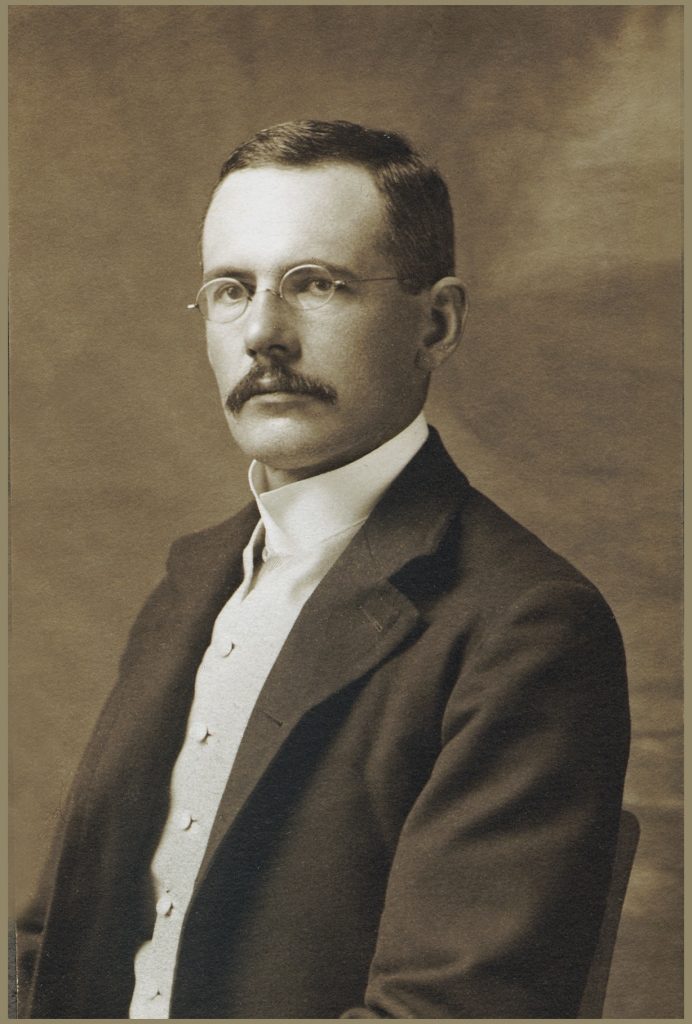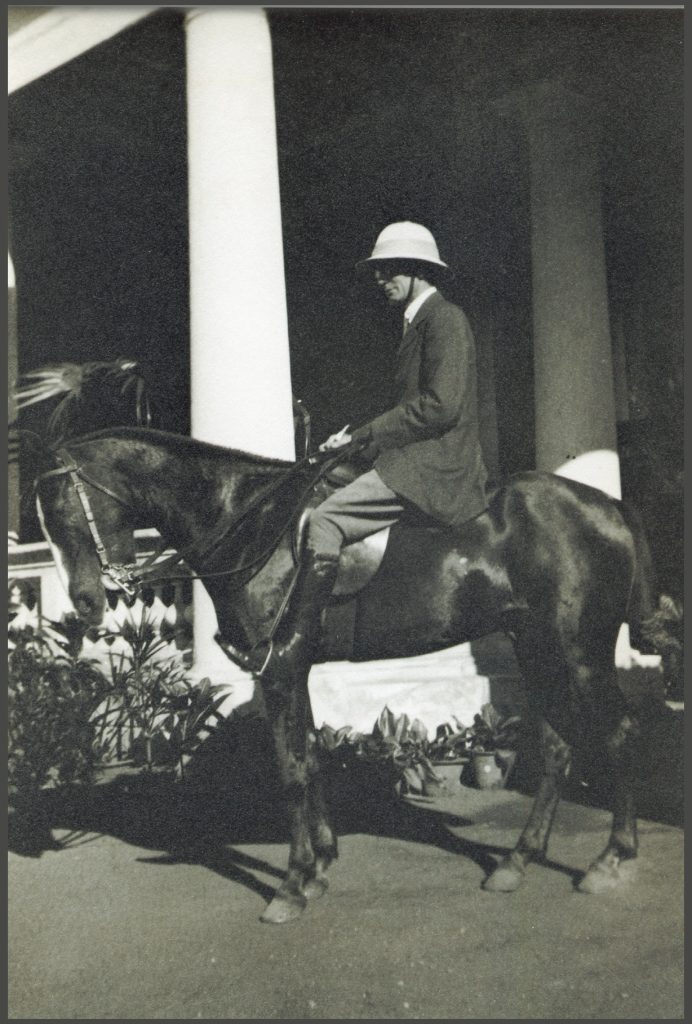Morris Travers was the first Director of IISc from 1906 to 1914. Before he died (in 1961), he left behind a typescript of his memoirs, notes and diaries at the archives of University College London. These writings have been meticulously compiled and edited by his grandsons, David MW Travers and John R Ainslie, and was recently published as his autobiography by IIScPress. Below is an excerpt from the book.

The main building, to house the library and the administration offices, faced due north onto a ‘maidan’ or open space. The laboratories first to be built were on the east and west of it, so arranged that wings could be added in the rear to provide increased accommodation as required. Space for other laboratories was reserved to the south of the main building. Bungalows for the Director and staff surrounded the maidan. Blocks of students’ quarters were placed to the west. They provided a separate room for each student, and a mess room and kitchen, situated at the ends of the lines of rooms for each group of 12 students. The kitchens and mess rooms were thus as far apart as possible. Lavatories and bath rooms were situated between each pair of lines of rooms. As I should be drawing students from all parts of India I had to consider the prejudices as to feeding for a variety of races and castes.
The land on a line drawn north and south through the centre of the main building and of the site generally was the crest of a ridge, the ground sloping slightly to the east and to the west. This made it possible, with a small amount of levelling to provide a maidan as a centre of the layout. Actually on the site of the main building was a ‘bund’ or bank stretching east and west forming a small ‘tank’ to catch rainfall from the south. It was old and ruinous. When we removed it to start building, we found in the centre of it the skeleton of a boy, who had clearly been sacrificed when the bund was made.
The subsoil was gneiss, a granite-like material, grey in colour. We proposed to build mainly in coursed rubble masonry using this material. Trial pits sunk about the site showed that immediately below the place where we intended to erect the tower of the main building (the site of the sacrifice just mentioned) was a small pocket of china clay, formed by the action of the water on the gneiss. We built the tower on a platform of light steel beams on concrete.
When we removed it to start building, we found in the centre of it the skeleton of a boy, who had clearly been sacrificed when the bund was made
Before Rudolf had left for England in February he had advertised for a man to act as Engineer in Charge of Building Works. He had many applications, mainly from ex-officials, but he selected W. Miller, a young Englishman, who had been trained in his father’s building business and had been for some time in India. He was an excellent draughtsman, and had experience in keeping building accounts and records, but not on the public works system. The Tatas, at Bhabha’s suggestion, were anxious that I should engage an ex-Mysore Public Works Officer. The idea was not supported by the Committee.
The work on the foundations, under the contract entered into in April with Mr. T. W. C. Skipp, an Indian-born Englishman, made rapid progress. Now Masson and Clibborn had estimated the initial cost of the buildings at Rs. 7.5 lakhs, the amount of the capital grant of the Government of India and the Mysore Durbar. When in the previous year I had gone into the cost of building with Stevens, it became clear that the estimate, which was for three departments only, was even for an Institute on this scale just a bit of wishful thinking. But I was not worried, as I supposed that the arrears of the income from the Tata endowment, which would amount to about Rs. 4.5 lakhs, could be used for building and equipment. In August of the previous year Mr. D. J. Tata had told me that we should have this money, but when I returned from England in September he had told me that we should not have it. This was Padshah’s doing. My development scheme included only the west wing of the main building and the tower which would serve as a water tower, together with three laboratories, one block of students’ quarters and a few bungalows. I set down the capital cost of building and equipment for this at Rs. 13 lakhs. I proposed to make up the deficit of 5½ lakhs from savings on income during the period of development, a procedure which was usual in the case of university institutions in the West. Also I knew already that I should receive financial assistance from the Governments of Bombay and Madras. My proposals as to procedure had not been questioned at the meeting of the Committee on March 23rd. The Tata representatives had neither attended the meeting nor commented on the Report in writing, so I imagined that opposition from that direction had ceased.
At this stage I opened an office in Bangalore. My Chief Clerk was a well-educated young Brahmin, Sundaram Iyer, and soon afterwards I engaged an accountant, Gundu Rao, also a Brahmin, and junior, Bashirodien, a Muslim. These three had no common home tongue, but they all spoke and wrote English as well as I did. I had two orderlies, Ramaswamy and Swilingum, old soldiers from the Madras Pioneers, both wearing many medals, and the usual coolies, and sweepers, etc. At Rudolf’s suggestion, all my lower grade workers were paid at a fixed monthly rate, plus a bonus of one anna in the rupee, which was not a wage but a reward for good service and conduct. On most mornings during my first weeks I had a complaint from the orderly, sweeper, coolie or others, the number of complaints increasing with the number of individuals. I heard the complaints and adjudicated. At last, one morning, when I heard a string of petty complaints involving everybody, I gave judgment: “All bonuses cancelled for the month. Dismiss.” “Oh,” said my clerk, “but this is most unfair, Sir.” I said, “These people have got to learn that while I am ready to listen to serious complaints, it is an offence to waste my time as has been done this morning.” The punishment was actually remitted on pay-day, but petty complaints ceased. I held a durbar every pay-day, paying the people myself and hearing complaints. Very rarely did I have trouble. In all my life I have never been better nor more faithfully served than I was by all ranks of my Indian staff, subordinates and servants. I am proud to think that they all became attached to me.
In all my life I have never been better nor more faithfully served than I was by all ranks of my Indian staff, subordinates and servants. I am proud to think that they all became attached to me
A very curious thing happened a few days after I had opened my office. On the morning of March 31st, when I came into the office, my clerk said to me: “Sir, I hear that there is a large sum of money for you in the Resident’s Treasury, and that if you don’t take it away today you will not have it.” I drove to the Treasury where I was told that they had Rs. 87,000 from the Government of India for me. As the afternoon was a holiday, I must clear it before midday or the grant would lapse, as all grants did at the end of the financial year. Also I must take the money in silver rupees. I drove to the bank, obtained the service of a couple of clerks and took away the boxes of rupees in bullock carts.
Now Government had promised to pay the grant of Rs. 87,000 a year from January 1st, so only a quarter of the sum was due. However, I banked the money in a special account, making good the value of five bad rupees myself, and decided to talk to the Finance Department about it when next I visited Simla or Calcutta. Then, when I saw Mr. Baker, he told me that at the end of each financial year there remained certain balances which had to be liquidated. Knowing that the Institute was short of capital funds he had kindly made up our grant to the full annual amount.
On April 10th I went to Bombay. I lunched at Government House, and had a long talk with the Governor about elementary science education, the first of many such talks.
I saw D. J. Tata but he had no comment to make on my Report. Much of my time was spent with the architects with whom I had to discuss the estimates for the buildings, which I proposed to lay before the Provisional Committee (1908) at their next meeting. I have no further record of my doings during the week I spent in Bombay. On the last night I dined with Burns. He was leaving for home the next day, had wound up his domestic affairs, and had got in temporary staff to cook the dinner. I felt unwell next morning, worse in the mail train to Poonah, and suffered very severely internally during the next thirty-six hours in the train on my way to Bangalore. When I arrived there, I had to be assisted from the railway carriage. Was it food poisoning?
I was still very unwell when I went to Ootacamund for the second meeting of the Provisional Committee (1908) on April 23rd. Again only Fraser, the Dewan, Hay and I were present. The Dewan was anxious that the contract should be given to an Indian contractor, but the tender by Mr. Skipp was the most favourable and was accepted. After the meeting, Hay and I lunched with the Frasers. I note in my diary: “The more I see of them, the more like them.” It was my first visit to Ootacamund. I enjoyed it, but I could only stay there for two nights. Work on the buildings commenced immediately, but I have no exact record of progress. The foundations were to be finished by September. To hasten the work I noted that the Committee agreed to a proposal to purchase an engine and mortar mill, and to rent it to the contractors. The Tata representatives had not appeared at the meetings in March and April, and as we were actually spending money donated by the Government of India and the Mysore Durbar, I thought that I was justified in proceeding in consultation with Fraser and the Dewan.

After the second meeting of the Provisional Committee (1908) I settled down in Bangalore. I rented a bungalow: West Bank, Avenue Road, Bangalore City. It was built of unburned bricks, with burned bricks around door and window openings, and covered with chunam (lime plaster); it was white-washed and flat-topped, with a pillared verandah. It looked palatial when seen from the bottom of the compound (garden), and it certainly was comfortable, but I was kept wondering why the structure didn’t collapse. I bought a buggy, holding two with a dicky [a British slang for a male donkey] for the saice [a stable attendant] behind, and a bay waler cob to drive in it. Marvel was an excellent trapper. I tried to ride him but he was too much for me. I also bought a beautiful little half-Arab, Peter Pan, for a hack, and on him I used to ride out to the building site early every morning.
(Reproduced with permission from IIScPress, and David MW Travers and John R Ainslie)




